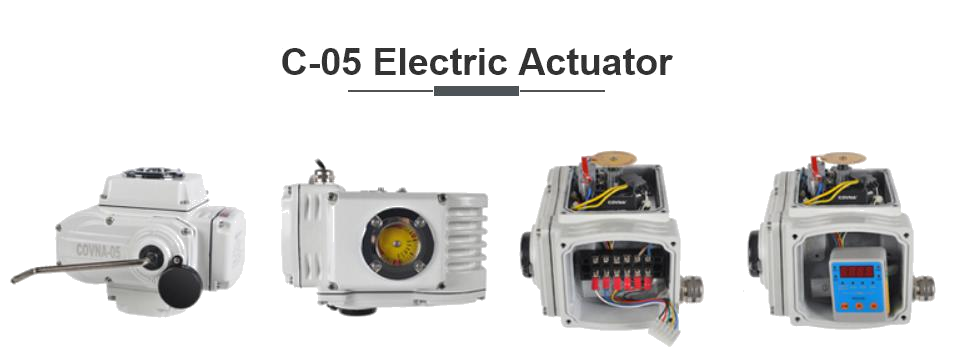COVNA Products




HK60-D-C Cast Iron Fluorine Lined Electric Butterfly Valve
This wafer type butterfly valve is for chemical industry. Adopt PTFE as the seal and disc which has a powerful ability of anti-corrosion. Suitable for acid, alkali, and other media flow control. Disc plate with frame structure, high strength, flow area, flow resistance. The valve with more and more tightly sealed off function, a reliable sealing performance.
| Model | HK60D-C |
| Torque Range | 50Nm to 400Nm |
| Size Range | DN50 to DN400 (2in to 16in) |
| Pressure | 10bar, 16bar |
| Temperature | -10℃ to 180℃(14℉ to 356℉) |
| Voltage | DC-12V, 24V; AC-24V, 110V, 220V, 380V |
| Medium | Acid, alkali, etc |
Anti-corrosive Electric Butterfly Valve
- Torque range is 50Nm(442 in-lb) to 2500Nm(22123 in-lb).
- It could be equipped with on off type actuator, modulating type actuator and intelligent type actuator
- Easy automation/Retrofit possible/Safe operation
- Steam lined valve disc ensures lower pressure drop
- Size range from 2 inch to 16 inch, size ia available to custom
Technical Parameters of Valve Actuator

| ON/OFF Type | Feedback: the active contact signal, passive contact signal, resistant, 4-20mA |
| Regulation Type | Input & Output signal: DC 4-20mA, DC 0-10V, DC 1-5V |
| Field Operation | The field, remote control switch regulation and MODBUS, PROFIBUS field bus |
| Voltage optional | AC 110-240V 380V 50/60Hz; DC12V, DC24V, Special voltage can be customized |
| Protection Class | IP65 |
| Model | 05 | 10 | 16 | 30 | 60 | 125 | 250 | 400 |
| Torque Output | 50Nm | 100Nm | 160Nm | 300Nm | 600Nm | 1250Nm | 2500Nm | 4000Nm |
Technical Parameters of Valve Body
| Valve Body | Valve components | ||
| Nominal size | DN50-DN400 | Sealing material | PTFE |
| Body Material | Cast Iron,WCB,304,316 | Disc Material | PTFE |
| End Connection | wafer, flange, lug wafer | Feature | Acid and alkali resistant |
| Operating Pressure | PN1.0MPa, PN1.6MPa | Applicable media | Water, Air, Gas, Oil, Liquid |
| Structure | Midline structure/A-Type | Design standard | ISO, DIN, IDF, SMS, 3A |
Technical Parameter of Valve Body:
| Nominal Size | DN15-DN200 | Body Material | PVC, UPV, CPVC, PVDF and PPH |
| End Connection | True Union, Double Union Thread | Structure | T Port / L Port |
| Operating Pressure | 1.0 / 1.6 MPa (10 / 16 bar) | Voltage Tolerance | ±10% |
| Suitable Media | Corrosive media, Water, Air, etc | Temperature Of Media | -5~80℃ (23℉~176℉) |
| Design standard | ISO, DIN, IDF, SMS, 3A | Orifice(mm) | 15, 20, 25, 32, 40, 50, 65, 80, 100 |
Package & Shipping:
As a professional electric ball valve manufacturer, COVNA aims to provide our customers the best quality products with the most competitive pricing, on-time delivery and full warranty service with omprehensive service from start to finish, encompassing consultation through to after sales service, full support in every respect and ensure that you are accompanied at each stage of your project.
Company Profile:
Factory Profile:
Company Certificates:
Purchase Guide:
● Confirm the valve size you need. We offer this Cast Iron Fluorine Lined Electric Butterfly Valve in 1/2in to 4in.
● Confirm the valve body material you need. We offer this Cast Iron Fluorine Lined Electric Butterfly Valve material.
● Confirm the connection standard. We offer this Cast Iron Fluorine Lined Electric Butterfly Valve in ANSI, JIS, DIN, and UK standard.
● Confirm the pressure and working temperature. Pressure and temperature are the important points and those may affect the cost.
● Confirm the voltage you need. The right voltage could help your valve operate better.
● Tell us your medium. Different medium has different features and we will help you to select the valve basic on the medium requirements
● Confirm the actuator type you need. We have on/off type, modulating type, intelligent type, explosion-proof type, IP68 type and auto return type electric valve actuator for your project.
Any requirements please tell us like core material, sealing material, or connection standard. We could help you to custom the valve you need.
More infomation, please send message to us. Quote will be provided within 2 hours! [email protected]
Technical Parameter of Actuators:
| Model | 5 | 10 | 16 | 30 | 60 | 125 | 250 | 400 |
| Torque Output | 50Nm | 100Nm | 160Nm | 300Nm | 600Nm | 1250Nm | 2500Nm | 4000Nm |
| 90°Cycle Time | 20s/60s | 15s/30s/60s | 15s/30s | 15s/30s | 30s/60s | 100s | 100s | 100s |
| Angle of Rotation | 0-90° | 0-90° | 0-90° | 0-90° | 0-90° | 0-90° | 0-90° | 0-90° |
| Working Current | 0.25A | 0.48A | 0.68A | 0.8A | 1.2A | 2A | 2A | 2.7A |
| Starting Current | 0.25A | 0.48A | 0.72A | 0.86A | 1.38A | 2.3A | 2.3A | 3A |
| Drive Motor | 10W/F | 25W/F | 30W/F | 40W/F | 90W/F | 100W/F | 120W/F | 140W/F |
| Product Weight | 3kg | 5kg | 5.5kg | 8kg | 8.5kg | 15kg | 15.5kg | 16kg |
| Voltage Option | AC 110V, AC 220V, AC 380V, DC 12V, DC 24V | |||||||
| Insulation Resistance | DC24V:100MΩ/250V; AC110/220V/380V: 100MΩ/500V | |||||||
| Withstand Voltage | DC24V:500V; AC110/220V:1500V; AC380V:1800V 1Minute | |||||||
| Protection Class | IP65 | |||||||
| Installation Angle | Any | |||||||
| Electrical Connection | G1/2 Water-proof Gable Connectors, Electric Power Wire, Signal Wire | |||||||
| Ambient Temp. | -30℃to 60℃ | |||||||
|
Control Circuit
|
A: ON/OFF type with light indicator signal feedback | |||||||
| B: ON/OFF type with passive contact signal feedback | ||||||||
| C: ON/OFF type with resistance potentiometer signal feedback | ||||||||
| D: ON/OFF type with resistance potentiometer and neutral position signal feedback | ||||||||
| E: Regulation type with servo control module | ||||||||
| F: DC24V/DC12V dirct ON/OFF type | ||||||||
| G: AC380V three-phase power supply with passive signal feedback | ||||||||
| H: AC380V three-phase power supply with resistance potentiometer signal feedback | ||||||||
| Optional Function | Over Torque protectors, dehumidify heater, stainless steel coupling & yoke | |||||||
The actuator on my automated valve operates, but the valve won’t turn. Why?
Most likely the valve stem or actuator coupling is broken.
Why doesn’t my valve open or close completely when the actuator operates it?
The electric actuator limit switches or the pneumatic actuator position stops are not correctly adjusted.
When I energize the solenoid on my pneumatic actuated valve, the valve won’t turn. How come?
Probably because there is no air pressure to the solenoid or dirt has jammed it. Also, debris might be trapped inside the valve. Or, the air pressure is not sufficient to operate the actuator. Remember: measure air pressure at the actuator, not at the compressor.
Can I buy an actuator from one manufacturer and mount it to a valve from another manufacturer?
Maybe. First, be sure that the actuator torque output is sufficient to turn the valve reliably. Second, you will have to fabricate a custom mounting bracket and coupling to connect the actuator to the valve.
What happens if I lose power to my electric actuator in the middle of an actuation cycle?
The valve will stop somewhere between full open and close. When power is reapplied to the original circuit, the actuator will complete the cycle.
I ordered a fail open pneumatic actuated valve by mistake. I needed a fail closed one. What can I do?
To make the change just remove the actuator from the valve and turn it, or the valve stem, 90 degrees and remount the actuator.
I’ve installed my automated valve in the line, but now I don’t know if the valve is in the open or closed position. How can I find out?
Remove the actuator from the valve and check the valve stem. Most ball valves have stem flats at right angles to the flow when the valve is in the off position. On butterfly valves check the stem flow arrow marking.
Do I have to have the solenoid valve that controls the air supply to my pneumatic actuator mounted right on the actuator?
Remove the actuator from the valve and check the valve stem. Most ball valves have stem flats at right angles to the flow when the valve is in the off position. On butterfly valves check the stem flow arrow marking.
How do I wire up my electric actuator?
Check the electric wiring schematic that came with the actuator for the correct hookup. Sometimes a copy is inside the actuator cover. If it is missing, don’t guess about the connections. Call the manufacturer for a schematic.
I’ve just installed an electric actuated valve and when I power it, it turns the valve 360 degrees and won’t shut off. What’s wrong?
The actuator is wired incorrectly (check the schematic accompanying the actuator), or the external control switch is not the correct type for the actuator.
My electric actuators cycle time is way too fast, can I slow it down?
Not unless you bought it with an optional speed control.
I just replaced a solenoid valve with an electric actuated valve and it won’t work. Why?
Actuators and solenoid valves require different types of electrical control switches. SPDT for actuators, SPST for solenoids. Check the actuator wiring schematic for the correct wiring and switch type.










_2022_03(1).png)















